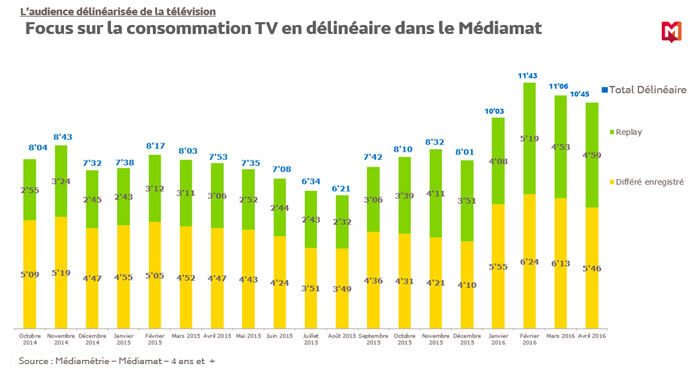- Home
- Results & Studies
- Replay accelerating in catch-up mode
Replay accelerating in catch-up mode

More and more of them are slowly devoting more and more time to it. These new fans are predominantly under 50 years old, working, and in higher income groups. How much will TV consumption change?
When TV first became popular, who would have imagined that it would one day be possible to catch up on a missed programme without budging from one's chair? It was unthinkable, and the remote control didn't even exist! Today, TV that I want, when I want, where I want it has become commonplace.This cultural shift accompanies the diversifying ways programmes are received in households, explained Jean-Pierre Panzani, from Médiamétrie's Television department.Reception by ADSL/fibre served as a boost; it equips 45.6% of households, 3 times more than in 2009.
The TV: premiere catch-up screen
Catch-up services have been able to simplify TV viewers' lives. "All generations can access it", explained Panzani. The viewer is no longer dependent on the times of live broadcasts. Now the TV set has become the premiere screen for watching catch-up TV; for several years, the catch-up screen was the computer".
Almost all TV channels offer a replay service. One can catch up with a flood of content: mainstream channels offer 92% of their programmes broadcast between 5pm and midnight in replay mode (source: CNC). Catch-up programmes generate advertising revenue of 90 million euros (source: IREP). For the record, the amount for TV media overall is 3.2 billion euros.
There are now 4.4 million individuals in total 15 and over who watch a catch-up programme every day (October-December 2015), on any screen (TV, computer, tablet or smartphone). Catch-up TV is constantly expanding its audience; it has doubled in one year. On average 2.6 million individuals are counted every day catching up with a programme on their TV set, and 2.1 million on their computer, tablet or smartphone.
Comment le panel Médiamat a intégré le rattrapage
Le Médiamat prend désormais en compte 69 services de catch-up dont 40 chaînes thématiques. Depuis janvier 2016, les audiences issues du panel de près de 5000 foyers (plus de 11.400 individus âgés de 4 ans et plus, représentatifs de la France entière) intègrent les programmes regardés en live et en rattrapage et Médiamétrie est en mesure, pour toutes les chaînes appréhendées, de détailler par programme l’apport de la catch-up. Chaque chaîne a un identifiant (technologie du watermarking audio) indissociable du timestamp, le marqueur de la date et de l’heure de la diffusion en live. En 2011, le différé (enregistrement personnel + timeshifting) est intégré au Médiamat. Mais c’est en octobre 2014 que la catch-up sur téléviseur intègre le Médiamat, en plus du live et du différé. Depuis janvier 2016, Médiamétrie est en mesure, pour toutes les chaînes, de détailler par programme l’apport de la catch-up, jour par jour, la performance définitive du programme étant donnée à J+ 7. Dès lors que le programme a été diffusé à l’antenne, l’audience Médiamat inclut celle du programme regardé en rattrapage (contenu intégral ou extrait) ou en preview (proposé par le service de rattrapage). En revanche, le Médiamat n’inclut pas les programmes bonus (non diffusés à l’antenne) ni les programmes exclusivement dédiés au service de rattrapage (non diffusés à l’antenne). Un contenu proposé en replay qui n’est pas strictement identique à celui diffusé à l’antenne (version abrégée ou allongée) est considéré comme un contenu bonus.
The delinearised audience: 1 hr 35 min per day
Every day catch-up attracts 4.4 million people, who spend 1 hr 35 min (VTV) per day on TV. The entire population devotes on average 11 minutes per day to catch-up, compared with 3 hr 43 min on average with live broadcasts (January-April 2016). This practice contributes to the increase in TV viewing time. The individual viewing time for TV media in catch-up mode has, in fact, gained three minutes in one year.The individual viewing time for TV media in effect totalled 3 hr 54 min on average over the period January-April 2016.

Catch-up appeals especially to those under 50 year’s old, working, and in higher income groups
TV viewer habits are changing, but they are not all changing at the same pace. The same trend applies to younger generations, who are better at mastering the technology than their elders, and watch fewer live broadcasts than them. Those under 50 represent 60% of the catch-up audience, compared to 4 out of 10 for live.In all, the catch-up audience is 38.8 years old compared to 43.2 years for the live audience.
Another marker for the catch-up audience is professional activity. Nearly 58% of the delinearised audience are working people, compared to 45% for live. They work, are more often in motion, lack time and have less chances to be on time or even present when a programme's live broadcast begins. Now they can catch up with it. The phenomenon is identical among those in higher income groups: higher socio-professional categories represent nearly 30% of the catch-up audience, while they only represent 20% of the live audience.
Catch-up, mainly in prime time
The content broadcast live in prime time is the type mostly shown in catch-up. More than half of catch-up (52.4%) comes from a programme broadcast between 9 and 11pm.
And what days do catch-up fans choose to view their programmes? Weekends especially, in view of availability, and Sunday is preferred to Saturday (7 min 30 sec vs. nearly 6 min).
Fiction, the champion of catch-up
Are the preferred programme genres known? Fiction – series and TV movies – leads by a wide margin; the addiction is phenomenal. This programme genre takes up to half (50.7%) of the time catch-up fans spend. Audience ratings for catch-up pull ahead even more when the programme earned good ratings live. "Le secret d'Elise" on TF1 was watched via catch-up by 1.2 million TV viewers. "L'emprise" on France 2 by 936,000 fans, and "Plus belle la vie" on France 3 by 561,000. Challenger content that performed the best in catch-up is the suspenseful entertainment competition "The Voice", "Danse avec les stars", "Nouvelle Star" and "Koh Lanta": they made up 15.7% of the content watched via replay. Good ratings, but far from the champion – fiction.
Marc Pellerin
des médias
edition
definitions